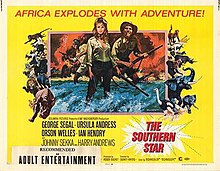The Southern Star (film)
| The Southern Star | |
|---|---|
 | |
| Directed by | Sidney Hayers |
| Screenplay by | David Pursall Jack Seddon |
| Produced by | Roger Duchet Nat Wachsberger |
| Starring | George Segal Ursula Andress Orson Welles Ian Hendry Johnny Sekka |
| Cinematography | Raoul Coutard |
| Edited by | Tristam Cones |
| Music by | Georges Garvarentz |
| Distributed by | Columbia Pictures |
Release date | 1969 |
Running time | 104 min. |
| Countries | United Kingdom France |
| Language | English |
The Southern Star (French title: L'Étoile du sud) is a Technicolor 1969 British-French comedy crime film directed by Sidney Hayers and starring George Segal, Ursula Andress and Orson Welles.[1] In French West Africa in 1912, an extremely valuable diamond is stolen. It was based on the novel The Vanished Diamond (French title L'Étoile du sud) by Jules Verne. The film's opening scenes were anonymously directed by Orson Welles - the last time he would direct scenes in another director's film.
Plot
Fortune hunter Dan Rockland (George Segal) comes to West Africa pretending to be a geologist. He is actually employed by Kramer (Harry Andrews), whose business is diamonds, and when Kramer's workers discover a huge uncut gem, Rockland is sent to retrieve it.
He and his African guide Matakit (Johnny Sekka) have opposition to contend with, first from Capt. Karl Ludwig (Ian Hendry), who is Kramer's security chief, and another is the diabolical Plankett (Orson Welles), who resents Rockland's interest in a woman named Erica (Ursula Andress).
The jewel is brought to Kramer and named the Southern Star, but at a party to celebrate the find, a power blackout leads to chaos. The diamond is gone. Matakit flees on a pet ostrich. Rockland sets out after him, with Erica coming along. Ludwig and his thugs are also in hot pursuit.
Plankett gets to Matakit first and takes him prisoner, setting a trap that leads to a shootout. In the end, just when it appears the diamond is safe, more ostriches show up and one of them just might have it.
Cast
- George Segal as Rockland
- Ursula Andress as Erica Kramer
- Orson Welles as Plankett
- Harry Andrews as Kramer
- Ian Hendry as Capt. Karl Ludwig
- Johnny Sekka as Matakit
- Michel Constantin as Jose
- Georges Géret as Andre
Reception
The film was the 18th most popular movie at the UK box office in 1969.[2]
The New York Times wrote, "The film evolves as a tongue-in-cheek, campy chase through Senegal's bush country, where it was shot in lovely pastel shades...Mr. Welles, looking like Buddha, swilling cognac, speaking in a pseudo-Cockney accent and perspiring in a white hunter's getup, lazily adds to the lampoon. "It's supposed to pull your leg," Mr. Segal explains to Miss Andress as he sets a trap for their pursuers. "The Southern Star" does just that, even if it isn't funny enough during a good deal of the trek";[3] while more recently, the Radio Times noted a "Splendidly photographed African adventure filmed on authentic Senegalese locations, but alas bearing the curse of the international co-production. Underrated editor-turned-director Sidney Hayers tries to pull together the Jules Verne-inspired plot and a cast that verges on the preposterous, headed by George Segal (far too urban for this type of trek), the ravishingly lovely Ursula Andress, and the great Orson Welles, who was obviously in need of the money. Brits, Ian Hendry and Harry Andrews bring some dignity to a romp that isn't sure whether it's comedy or adventure or both, but it looks good nevertheless."[4]
References
- ^ "BFI | Film & TV Database | L' ETOILE DU SUD (1968)". Ftvdb.bfi.org.uk. 16 April 2009. Retrieved 6 October 2010.
- ^ "The World's Top Twenty Films." Sunday Times [London, England] 27 Sept. 1970: 27. The Sunday Times Digital Archive. accessed 5 Apr. 2014
- ^ A. H. Weiler (29 May 1969). "Movie Review - - Pursuit of a Diamond". NYTimes.com. Retrieved 19 November 2016.
- ^ "The Southern Star - Film from RadioTimes". Radiotimes.com. Retrieved 19 November 2016.
External links
- 1969 films
- English-language films
- 1960s adventure films
- 1960s historical films
- British films
- British criminal comedy films
- British adventure films
- British historical films
- French films
- Adventure comedy films
- Films based on French novels
- Films based on works by Jules Verne
- Films directed by Sidney Hayers
- Films set in Africa
- Films set in the 1910s
- Films set in the French colonial empire
- Films shot in Senegal
- Mining in film
- Columbia Pictures films
